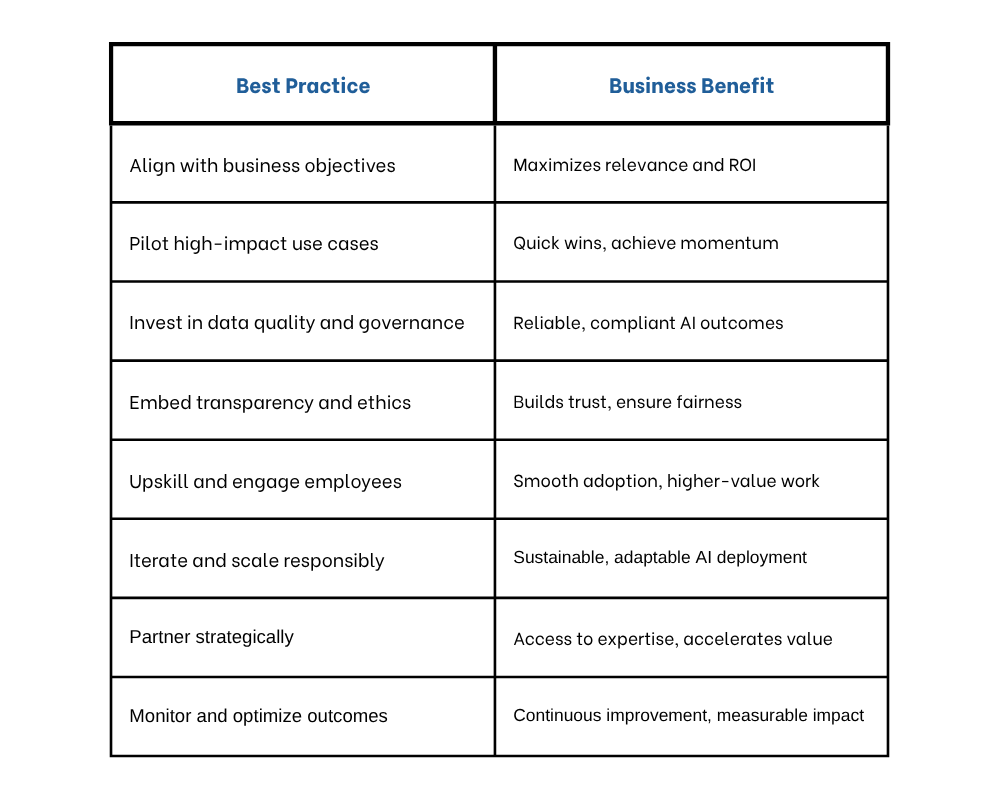Strategy & Applied AI: Cutting through the Noise.
June 12th, 2025
Everyone’s rightfully racing to “do AI” — but an important question is often overlooked in the scramble:
To what end?
It’s no longer a question whether a company should invest in artificial intelligence - it has undoubtedly arrived and embedded itself in the minds of those leading and shaping modern organizations. But in the sprint to act, many skip the most strategic step: Thoughtfully connecting those efforts to real value streams, real friction, real experiences customers care about...and transparently communicating the strategy.
Let’s be clear: AI is not a strategy. It’s a capability.
Without anchoring that capability to your organization’s most pressing problems…and aptly bringing transparency and prioritization to the matter…what develops is something resembling organizational chaos — no matter how powerful the algorithm.
Results? —> Experimenting for the sake of claiming experimentation. Teams pursue disconnected pilots, burn cycles chasing vendor demos, and misread what’s signal vs. noise - all without a shared understanding of the why. In other words, strategic drift.
What’s missing isn’t ambition - it’s strategy-led application. That’s where the concept of Applied AI enters.
So what is Applied AI in practice?
Applied AI refers to the use of AI techniques such as machine learning, natural language processing, and predictive analytics in targeted, domain-specific applications that solve concrete business problems.
“Applied AI bridges the gap between abstract algorithms and real-world use cases by aligning data science to business context and decision-making.”
To put Applied AI into context, it helps to distinguish it from the foundational models driving today’s headlines. While large foundational models (like GPT-4 or domain-trained LLMs) are essential enablers, value is unlocked only when those capabilities are embedded into specific workflows — automating claims processing, predicting customer churn, enriching product data, surfacing customer search intent, or accelerating customer support.
It’s not about choosing between foundational models or applied AI. It’s about building the bridge between them with strategy as the architect. In business, where AI seemingly has potential impact everywhere, best practices (see further below) in Applied AI help bring order and transparency.
The Strategic Disconnect
Despite all the investment and excitement, most companies aren’t getting real traction from AI. Most companies remain stuck in experimentation rather than capturing value from AI:
BCG (Oct 2024) reports that 74% of companies are piloting AI but only 4% generate substantial enterprise value and 22% showing early promising gains. Those benefiting early on seem to have narrowed their focus to a limited set of key business functions, i.e., linked the work to a more focused company strategy and targeted list of use cases.
The Wall Street Journal (Apr 26, 2025) highlights a stark reality: While 78% of companies deploy AI in at least one function, only 1% have scaled AI enterprise-wide, and most report cost savings under 10% and revenue gains below 5%.
Clearly, there’s value creation through AI but at this stage, companies are continuing to work their way through determining what AI’s real value is to their business. As the hype cycle continues, there will undoubtedly be companies that hit the “trough of disillusionment” with a harder thump than others - I contend those will all likely have one thing in common: No focused strategy.
Key takeaway:
“AI without strategic anchoring is noise — pilots don’t pay the bills. Only when AI is aligned to real friction‑points, clear inefficiencies, and ladders up to a larger cohesive strategy does it deliver measurable ROI.
”
That’s why at BANKDENS, we don’t treat AI as the starting point - we treat it as one of many tools at the strategy table. And we’ve built a framework that ensures it shows up where it actually matters.
The BANKDENS Approach
Our Lean Strategy Diagnostics and Applied AI Assessments bring classical structured problem-solving to today’s most complex opportunities - AI included.
Here’s what sets it apart:
We start with friction, not features
We engage decision-makers across silos and employees up and down the org chart to ensure alignment early in the process
We move quickly to synthesize insights into executable plans
And we anchor innovation, AI or otherwise, to strategic business relevance, not hype or vendor capabilities
It’s a strategy-first approach that clarifies what’s working, what’s missing, and where emerging capabilities, like AI, can actually drive value.
Final Word: Strategy Before Shine
If your AI initiative doesn’t map to defined business friction or measurable strategic goals, you’re not investing — you’re gambling. While an “AI-first” mindset has taken hold in modern companies, it’s a mistake, never mind expensive, to spin up cycles of experimentation to chase hype. That’s not to say there is no place for experimentation. The point is like any capability, AI needs to map to a larger purpose and value and the experiments inform that plan.
Case in point: I’ve witnessed organizations prioritize tests and investments in AI-generated product review summaries but not basic product data quality capabilities (AI-powered or not) that could have prevented over 30% of negative reviews, never mind reclaimed millions in lost sales from customers who were shown to exit online product pages entirely on account of inconsistent product data.
When everyone is moving at the speed of business, that’s exactly where a strategy-first approach is unifying.
I’d love to help you make sure that type of signal cuts through the noise and the shine. In the meantime, we hope you find our cheatsheet for Best Practices for Applied AI in Business useful as you scale:
Connect with us to run a diagnostic sprint and pressure-test where your strategy meets capability.

